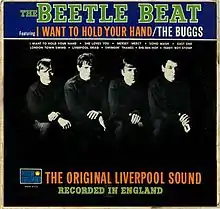The Buggs
The Buggs was the name of two short-lived soundalike bands of the mid-1960s inspired by The Beatles craze. One group had a single on Soma Records of Minnesota, and the other group ( whose actual name was the Coachmen V) had a full album on Coronet Records.
The band with the single
In 1964, a single credited to The Buggs was released on Soma Records. This group, actually a band called Andy & the Manhattans,[1] hailed from Omaha, Nebraska, and the single was recorded at Amos Heilicher's Kay Bank Studios in Minneapolis, Minnesota.[2]
The single, "Buggs Vs. Beetles (I Want To Hold Your Hand)", is not a straight cover, but is instead a parody mocking the Beatles. The B-Side, "She Loves Me", is a straight cover of "She Loves You" despite the title change.
Discography
- Soma 1413 45rpm single, with picture sleeve. A side: Buggs Vs. Beetles (I Want To Hold Your Hand); B side: She Loves Me (1964).
Compilations
- Better Than The Beatles: 26 Tunes That Failed to Oust the Fab Four From The Charts (Knight (LP)) includes "Buggs vs. Beetles (I Want to Hold Your Hand)"[3]
The band with the album
The album credited to the Buggs, The Beetle Beat, was released in February 1964. It consisted of covers of Beatles songs ("I Want To Hold Your Hand", "She Loves You") with some originals, many written by Lor Crane & Joan Kingsbury ("Big Ben Hop (Sassy Sue)", "Liverpool Drag (Why Won't You Leave That Man?)", "Teddy Boy Stomp ("I'll Never Never Never Leave You)", "Mersey Mercy (You Got Me Bugged)", "Swingin' Thames (That's For Sure)", "London Town Swing 9Why Can't You Love the Boy Who Loves You0", "East End (Since You Broke My Heart)", and a cover version of "Just One Look" (as "Soho Mash").[4]

Despite the cover displaying "The original Liverpool sound", and claiming to have been "Recorded in England," The Buggs hailed from New Jersey and the album was actually recorded in the New York/New Jersey area.
The Buggs were never a real band; rather, the album was recorded by a group named the Coachmen V from Bergen County, New Jersey, under the impression that it would be released under that name. The album was produced by Goldie Goldman, who hired a songwriter to write the original tracks. Some rehearsing of the material was done in Nyack, New York at Scotty's Bar, after which the album was recorded. Band personnel included Bill Omolski on bass, Gary Wright (later to have a successful solo career with hits such as "Dream Weaver") on organ and vocals, Frank Zillitto (1942 - Dec. 2017) on guitar, Steve Bogue on drums, and either Eddie Brick or Jimmy Carrol on lead vocals. Brick and Carrol both worked as lead vocalist for the Coachman V at different times, and it is not known which one sang on the Buggs album. Studio musician Trade Martin also played on album.
Band members were surprised (and unhappy) when they discovered that album had been released under a different band name, under false pretenses, and with models representing the band members. No royalties were ever paid, and The Buggs ceased to exist. In 1966, Coronet released Boots a Go-Go (Coronet, CX-212-A: 1966) repackaging the same Beetle Beat album from two years earlier, now with a go-go music storyline on the back cover and a picture of a go-go dancer on the front and back covers. According to the back cover, the Buggs' "go go sound" was "grown up rock 'n' roll" played at discotheques and on Hullaballoo. Cleverly, no song titles were featured on the album's front or back cover so that unaware buyers would not know that this was exactly the same Buggs' music from their previous and, technically, only release. As a result, the record's label did not reference the "Boots a Go-Go" title as the original unsold Beetle Beat vinyl was simply repurposed inside.
Their influence may have been limited, but Devo's Mark Mothersbaugh said that Beetle Beat was his first album purchase, thinking it was a Beatles album. Mothersbaugh said, "One track pissed me off so much it eventually inspired the nasty Devo song, 'U Got Me Bugged'."[5] In 2009, reissue label Master Classics brought Beetle Beat to iTunes Store and other online music services including Spotify.
Discography
- Coral 62398 45rpm single, "You Got Me Bugged"/"Sassy Sue", The Pacers, 1964. Also featured on "The Beetle Beat" album.
Compilations
- At The Hop (Coronet LP, CX-244: 1964) and Starring Frankie Valli (on Coronet's Premier label PS-9052: 1964) contain a few Buggs songs from Beetle Beat;[7]
- Discotheque (Coronet LP, CX-252: 1964) featured five songs from Beetle Beat. Also released in a stereophonic version, with label number CXS-252, as well as in Germany, with a band name of The Crossbrakers (Vogue Schallplatten, ZS 10030 PR: Year unknown).
- Starring the Young Rascals (Coronet LP, CX-283: 1966) featured two existing Buggs' songs from Beetle Beat under new titles.
- Boots a Go-Go (Coronet LP, CX-212-A: 1966) repackaged the same Beetle Beat album as a go-go album.
- The English Sound (Premier LP, PS-9016: 1967) featured five Buggs songs for all of Side B, this time crediting them as The Submarine Spitfires.
References
- "Andy and the Manhattans". Retrieved 2019-09-13.
- "Radio Rumpus Room playlist of April 5, 2002". Archived from the original on May 21, 2008. Retrieved 2006-03-20.CS1 maint: bot: original URL status unknown (link)
- Better Than The Beatles at AllMusic
- Shepard Ritzen (February 26, 2015). "(the) Buggs - The Beetle Beat". Thrift Store Music. Retrieved June 14, 2020.
- Smith, Kevin C. (2013) Recombo DNA: The Story of Devo. Milwaukee, WI: Hal Leonard Corporation / Jawbone Press.
- Robert Plante. "Coronet Records Discography". Forbidden Eye Design. Retrieved October 14, 2014.
- Jason (February 19, 2006). "The Buggs "The Beetle Beat" (Coronet, CX-212, 1964)". Scar Stuff. Retrieved October 14, 2014.